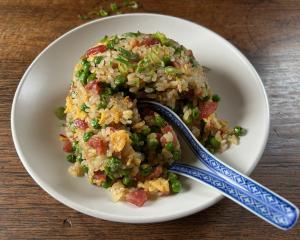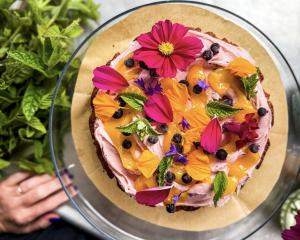You can't escape tortillas in Mexico.
They turn up everywhere in many shapes and sizes, topped or filled with tasty tidbits and used instead of plates or spoons.
Like fresh chilli salsas and lime wedges, tortillas are served with whatever food you order in traditional Mexican eateries.
Mexicans love them and during four weeks exploring central and southern parts of Mexico, we came to love their characteristic flavour as well.
Corn tortillas are as old as the ancient indigenous Mexican civilisations that built such magnificent cities as Teotihuacan, Monte Alban and Chichen Itza.
These corn flatbreads have been made in the same way for two or three millennia, and the preparation remains essentially unchanged, although technology has replaced some of the tedious work such as grinding the corn.
The characteristic flavour of tortillas comes from an ancient process called nixtamalization which increases the nutritional value of the grain.
Corn kernels are cooked and soaked for several hours in a mineral lime solution - you can buy pieces of lime in the markets if you want to do it yourself.
Then the corn, now called nixtamal, is drained and ground to form a dough called masa.
This is shaped into flat rounds and cooked briefly on both sides on a comal, a flat iron pan - at least that is the traditional way.
Now there are many easier ways to get your tortillas.
In Mexican cities you can buy fresh masa ready to shape and cook, or cooked tortillas ready to reheat.
Or, you can buy masa harina, a dried, powdered form of the dough, which just needs to be mixed with water and shaped to make tortillas.
Masa harina is available here in international sections of good supermarkets.
As we wandered round markets and side streets in cities and towns, we'd come across small food stalls cooking tortillas with various fillings and toppings.
They make a delicious snack any time of day and several make a meal.
They are the essence of quick, takeaway food.
A tortilla, a scoop of shredded cooked chicken, pork or beef, a dollop of salsa and a squeeze of lime, roll it up and you have a taco.
Fill the tortilla with cheese (and maybe other things, such as mushrooms or cooked nopale - the thick leaf of a cactus) and heat until it melts and you have a quesadilla.
Make your tortilla large and oval, fill it with a scoop of mashed beans and other things like cheese, spinach or mushrooms and fold it over and you have a huarache, so named because it's the shape of a sandal.
Toast a large platter-sized tortilla until it's crisp and top it with mashed beans, cheese, tomatoes and perhaps some fresh spicy chorizo and you have a tlayuda, a specialty in Oaxaca, a bit like a very thin, crisp pizza.
In the steamy north of Yucatan they make papadzules - tortillas rolled around chopped hardboiled eggs and smothered with green pumpkin seed and red tomato sauces.
There are thicker versions, some fried before being filled or after being rolled such as chalupas, sopes, tostadas and tacos d'oro.
There's even tortilla soup, a chicken broth with strips of corn tortillas floating in the soup and more tortillas accompanying it.
Some of the best food of this sort comes from small stalls in markets where Mama cooks and her daughter or husband serve.
Tortillas are best freshly cooked, melting in the mouth with slightly crisp edges, and if we saw someone at the front of the restaurant shaping and cooking tortillas on their big, gas-fired hotplates, surrounded by bowls of mashed beans, chicken in tomato and chilli sauce, perhaps sliced mushrooms, avocado and tomato, we knew we were on to a good thing.
Stacks of tortillas, reheated and wrapped in a cloth to keep them warm and soft, can be a bit rubbery, especially as they cool.
Locals tear strips off and use them to scoop up stews or thick sauces like molé (a rich complicated sauce flavoured with spices, nuts and often chocolate).
The best thing to do with a stale tortilla is cut it up and toast or fry it to make totopos - known to us as corn chips.
Serve them with frijoles, cooked and mashed beans, and above all that wonderful Mexican sauce, guacamole.
I remember a particularly delicious tortilla wrapped around a chilli relleno, a large, mild chilli filled with cheese, crumbed and fried with of course an accompanying salsa.
Or the first tortilla we ate in Mexico, freshly cooked, filled with tender pieces of fried tongue and topped with a mind-blowing green salsa.
Or a taco arabe in Puebla, filled with meat sliced from a skewer like a doner kebab, and topped with a subtly hot brown salsa.
Or a simple soft tortilla with grilled chicken, cheese, avocado, tomato, onion and fresh chilli with a squeeze of lime juice at a market stall when we were hot and hungry after traipsing round some prehispanic ruins.
Tortillas and their variants are not the only way to eat corn dough.
It's also used in tamales, a real comfort food, found in steaming pots on street corners, in bus stations and markets, especially in the mornings.
It became a favourite breakfast.
Masa dough is wrapped in a corn husk or banana leaf, with a little flavouring - perhaps some spiced, shredded chicken or pork, or mole (a thick, flavourful sauce), then steamed for a couple of hours.
They are served piping hot - you unwrap the leaf and eat the steaming dough with the plastic fork or spoon that comes with it.
(Don't confuse corn tortillas with flour tortillas, made from wheat flour, which are more common in the north of Mexico and can be bought here in supermarkets. The flavour is quite different from the traditional corn tortilla.)
For a recipe and video on how to make tortillas and tacos, see our Flavours of Home column on www.odt.co.nz. Search for "Make tacos" or go to www.odt.co.nz/lifestyle/food-wine/57790/video-how-make-tacos












